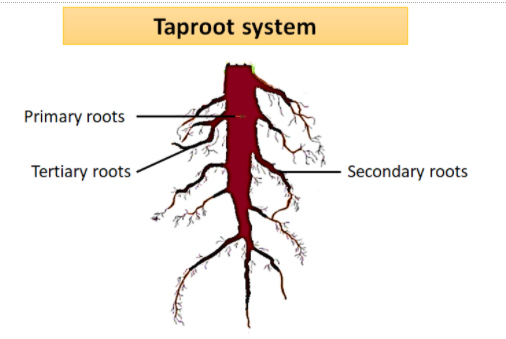
Which one of the following is an example of the taproot system?
(a) Wheat
(b) Mustard
(c) Millet
(d) Maize
Answer
481.8k+ views
Hint: The plant which is an example of the taproot system also shows alternate phyllotaxy in its leave’s arrangement. The flower of this plant is actinomorphic i.e. it can be divided into two equal radial halves in any radial plane passing through the center.
Complete answer:
An example of the taproot system is a mustard plant. In most of the dicotyledonous plants, the radicle directly elongates to form the ‘primary root’ which grows inside the soil. The primary root along with its branches constitutes the ‘tap root system.’
Additional Information:
-The root system in monocotyledonous plants is different. Here the primary root is short-lived. It is then replaced by a large number of roots. The origin of these new roots is from the base of the stem, this constitutes the ‘fibrous root system’. A classic example of the fibrous root system is seen in wheat plants. Millets being a monocotyledon also shows the same type of roots.
- Another type of root system is seen in plants like grass, Monstera, and the banyan tree. Here there is an arrival of roots from parts of the plants other than the radicle. Such roots are called ‘adventitious roots’.
-Taproots in carrot, turnip and adventitious roots in sweet potato, get swollen, and store food.

So, the correct answer is ‘Mustard.’
Note:
- Gymnosperms like Sequoia also have taproots.
- ‘Radicle’ is the first part to emerge out of a seedling.
- ‘Alternate phyllotaxy’ is the arrangement of leaves in which a single leaf occupies each node in an alternate manner. Some examples of such an arrangement are china rose, sunflower, along with mustard.
Complete answer:
An example of the taproot system is a mustard plant. In most of the dicotyledonous plants, the radicle directly elongates to form the ‘primary root’ which grows inside the soil. The primary root along with its branches constitutes the ‘tap root system.’
Additional Information:
-The root system in monocotyledonous plants is different. Here the primary root is short-lived. It is then replaced by a large number of roots. The origin of these new roots is from the base of the stem, this constitutes the ‘fibrous root system’. A classic example of the fibrous root system is seen in wheat plants. Millets being a monocotyledon also shows the same type of roots.
- Another type of root system is seen in plants like grass, Monstera, and the banyan tree. Here there is an arrival of roots from parts of the plants other than the radicle. Such roots are called ‘adventitious roots’.
-Taproots in carrot, turnip and adventitious roots in sweet potato, get swollen, and store food.

So, the correct answer is ‘Mustard.’
Note:
- Gymnosperms like Sequoia also have taproots.
- ‘Radicle’ is the first part to emerge out of a seedling.
- ‘Alternate phyllotaxy’ is the arrangement of leaves in which a single leaf occupies each node in an alternate manner. Some examples of such an arrangement are china rose, sunflower, along with mustard.
Recently Updated Pages
Can anyone list 10 advantages and disadvantages of friction

What are the Components of Financial System?

How do you arrange NH4 + BF3 H2O C2H2 in increasing class 11 chemistry CBSE

Is H mCT and q mCT the same thing If so which is more class 11 chemistry CBSE

What are the possible quantum number for the last outermost class 11 chemistry CBSE

Is C2 paramagnetic or diamagnetic class 11 chemistry CBSE

Trending doubts
Which is not a source of freshwater 1 Glaciers and class 11 chemistry CBSE

10 examples of friction in our daily life

The correct order of melting point of 14th group elements class 11 chemistry CBSE

Difference Between Prokaryotic Cells and Eukaryotic Cells

One Metric ton is equal to kg A 10000 B 1000 C 100 class 11 physics CBSE

What is the specific heat capacity of ice water and class 11 physics CBSE




